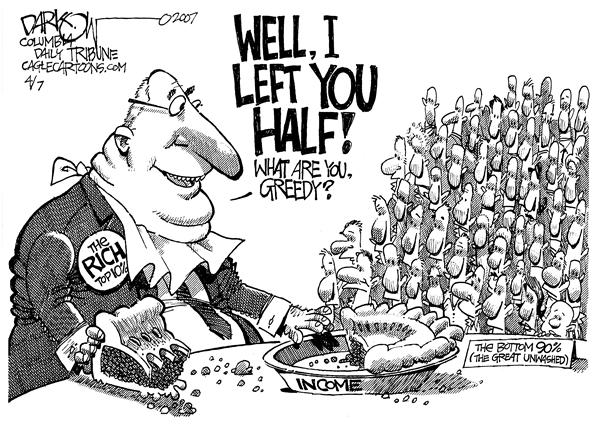The Gilded Age was an era in American history lasting from the end of Reconstruction to the election of Theodore Roosevelt, or 1877 to 1900. The era’s name comes from Mark Twain, remarking on the dangerous inequality and unequal distribution of wealth of the day, suggesting the growth was superficial, like a gold coating hiding something of little worth. The era was marked by gross income inequality (one estimate suggests that the top 1% of Americans owned 45% of the nation’s wealth), crippling poverty, volatile and devastating downturns, monopolies, lawmakers in the back pockets of corporate interests, and a vilification of the poor and labor unions. It is regarded as one of the darker periods of American history, and was home to the then biggest economic downturn of all time.
We’d like to think we’re beyond that, but reality begs to differ. In many ways, our era bears an unsettling resemblance to the Gilded Age. The top 1% owns more wealth than the rest of the nation combined. The world is still suffering the consequences of a massive economic downturn. Corporate regulations are continuously being loosened, and our top politicians are dependant on the money of the elite. Labor unions and the poor are blasted, the former for being a business killing blight that outstayed its welcome, and the latter for being lazy leeches that are totally dependant on the government.
The comparison isn’t perfect. For one thing, the biggest employer of the Gilded Age was manufacturing, not service. The poor are generally better off than their Gilded Age counterparts. The biggest money makers in the economy is now finance, not steel or railroads. The prevailing Social Darwinist ideologies have been replaced with Libertarianism, though the similarities between the two are startling. But where the two eras share similarities are the most important, and perhaps the most defining challenge of our era.
There are many problems with having a second Gilded Age. For one, the original era showed us the danger of power being in the hands of too few. By simply buying our legislatures, the wealthy of then and the wealthy of now are able to push their agenda through Congress without resistance, which benefits them at the expense of nearly everyone else. The legislation of the Gilded Age and now reward those who already have the most wealth with things like deregulation, tax cuts, incentives, and subsidies. They also make it next to impossible to advance any new legislation that would address the unregulated markets, or protect workers.
Another huge problem that the two eras share is the dismal state of the working class. Both eras are home to many people blaming the struggle of the poor on the poor themselves, often spouting the tired line that if they just worked harder, they wouldn’t be in poverty. Services that help lower income families are constantly under fire. Labor unions, a service that can truly help workers, are actively being legislated against. Laws that would actually help lift up the working class, like a minimum wage hike, is being fought against tooth and nail. Thanks to corporate interests and general apathy, the working class is stuck in a condition that would be considered unacceptable by many.
So why has history repeated itself? The first reason is that the United States, since the Watergate scandal, has moved to the right, and continues to do so. This has allowed for things like Reaganomics and supply side economics to flourish, even though it only benefits the upper class. What’s truly puzzling is that since the Great Recession, voters have not moved to the left like in other economic downturns but further to the right, redoubling commitment to what should be regarded are defeated ideologies. History has repeated itself because voters place more faith in politicians that protect business and attack the working class.
The second reason is that the United States has lacked a strong liberal leader that is willing to fight the wealthy in the name of the lower and middle classes. Since Nixon, we’ve had three Democratic president, none of which can be regarded as strong liberals, and have generally been unwilling to use their power in a manner similar to Theodore Roosevelt. It took Roosevelt, a strong and active progressive, to bring an end to the Gilded Age and end the business practices that greatly damaged the working class. As of now the only high profile progressive in the Democratic party is Bernie Sanders, a man who cannot enact his proposals unless he had an army of like-minded legislators and government officials with him.
Things look bleak for America, not because of any security threats or who’s coming into the country, but because we’ve allowed our rich to become too rich, and our poor to become too poor. And unless people stop trying to solve their problems by electing the people furthest to the right and ignore the people willing to use the government to make a difference, then we aren’t going to change.


No comments:
Post a Comment